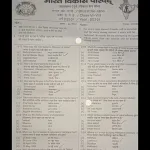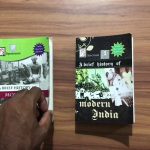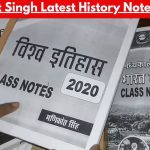Subject: Indian History
Who was the first woman ruler of India?
Razia Sultana
Which Indian freedom fighter is known as the “Father of the Indian Nation”?
Mahatma Gandhi
In which year did India gain independence from British rule?
1947
Who led the revolt of 1857 in Kanpur?
Nana Sahib
Who was the founder of the Maurya Empire?
Chandragupta Maurya
Who was the first President of independent India?
Dr. Rajendra Prasad
Which Mughal emperor built the Taj Mahal?
Shah Jahan
Who was the founder of the Sikh religion?
Guru Nanak Dev
What was the main objective of the Non-Cooperation Movement?
To resist British rule through nonviolent means
In which year was the Quit India Movement launched?
1942
Who was known as the “Iron Man of India”?
Sardar Vallabhbhai Patel
What is the significance of the Dandi March?
It was a protest against the salt tax imposed by the British
Who wrote the national song “Vande Mataram”?
Bankim Chandra Chatterjee
Which Indian ruler fought against Alexander the Great?
King Porus
Who established the Gupta Empire?
Chandragupta I
Which emperor embraced Buddhism after the Kalinga War?
Ashoka the Great
Who founded the Indian National Congress?
Allan Octavian Hume
What was the name of the ship on which Subhas Chandra Bose escaped from India?
SS Loyalty
Who was the first woman Prime Minister of India?
Indira Gandhi
Which historical site in India is famous for its rock-cut caves and murals?
Ajanta Caves
Subject: Indian Geography
Which is the longest river in India?
The Ganga (Ganges)
Which is the southernmost point of India?
Indira Point
Which is the highest mountain peak in India?
Kangchenjunga
In which state is the Thar Desert located?
Rajasthan
Which Indian state has the largest coastline?
Gujarat
Which is the largest freshwater lake in India?
Wular Lake
What is the capital of Arunachal Pradesh?
Itanagar
Which Indian river is known as the “Dakshina Ganga” or “Ganga of the South”?
Godavari
Which Indian state is known as the “Land of Five Rivers”?
Punjab
Which mountain range separates India from Central Asia?
The Himalayas
Which Indian plateau is known as the Deccan Plateau?
The southern part of the Indian peninsula
Which river flows through the city of Varanasi?
Ganga
Which Indian state is the largest in area?
Rajasthan
Which city is known as the “Pink City” of India?
Jaipur
What is the name of the Sunderbans’ famous tree species?
Mangrove
Which Indian river originates from Amarkantak?
Narmada
Which state in India receives the highest rainfall?
Meghalaya
Which city is called the “Silicon Valley of India”?
Bengaluru
What is the name of the narrow channel that separates India and Sri Lanka?
Palk Strait
Which Indian state is famous for its backwaters?
Kerala
Subject: Indian Culture & General Awareness
Which is the national flower of India?
Lotus
Which Indian festival is known as the “Festival of Lights”?
Diwali
Who wrote the Indian national anthem?
Rabindranath Tagore
Which dance form is associated with Kerala?
Kathakali
What is the currency of India?
Indian Rupee
Which is the national animal of India?
Bengal Tiger
Which Indian sportsperson is known as the “Little Master”?
Sachin Tendulkar
Which city is famous for the Golden Temple?
Amritsar
What is the national fruit of India?
Mango
Which classical dance originated in Tamil Nadu?
Bharatanatyam
Which is the official language of the Indian government?
Hindi and English
Which state is famous for its Bihu festival?
Assam
Which is the national bird of India?
Indian Peacock
Who is known as the Missile Man of India?
Dr. A.P.J. Abdul Kalam
Which Indian festival is celebrated with colors?
Holi
What is the full form of ISRO?
Indian Space Research Organisation
Which city is known as the “City of Lakes”?
Udaipur
Which Indian personality won the Nobel Peace Prize in 2014?
Kailash Satyarthi
Which Indian state is known as the “Land of Rising Sun”?
Arunachal Pradesh
Which Indian monument is a UNESCO World Heritage Site and symbol of love?
Taj Mahal
Recommended Indian Books for Bharat Ko Jano 2019 Preparation with Authors and Publications
1. Bharat Ko Jano – Gyan Prakashan (Bharat Vikas Parishad)
Content Type: Covers Indian history, geography, culture, politics, sports, and general awareness in a concise format. Ideal for factual, one-line quiz questions.
2. Know India – Ramesh Publishing House (RPH Editorial Board)
Content Type: General knowledge focused on Indian traditions, achievements, geography, and socio-political structure. Contains MCQs and short-answer style questions.
3. General Knowledge of India – Lucent Publications (Vinay Karna & Sanjeev Kumar)
Content Type: A wide variety of objective-type questions from Indian polity, economy, science, and culture. Useful for quick revision and competitive quizzes.
4. India: The Ultimate GK Book – S. Chand Publishing (Dr. Binay Karna)
Content Type: Descriptive and multiple-choice questions on Indian personalities, awards, inventions, and government systems. Questions are direct and factual.
5. Discover India Quiz Book – Orient BlackSwan (Sundari Venkatraman)
Content Type: Interactive quiz format with sections on Indian states, famous monuments, folk culture, and festivals. Encourages curiosity-based learning.
6. India at a Glance – Upkar Prakashan (M. Laxmikanth)
Content Type: Fact-based chapters on India’s constitution, administrative structure, defense, and geography. Great for fill-in-the-blank and match-the-following questions.
7. Indian Culture and Heritage – NCERT (High School Edition)
Content Type: Detailed insight into Indian art forms, ancient literature, historical monuments, and societal evolution. Questions often come in comprehension or concept-based format.
8. Know Your Country India – Arihant Experts (Arihant Publications)
Content Type: Multiple-choice and assertion-reason questions based on Indian statistics, census data, and development indices. Suitable for score-based quizzes.
9. India 2025: Vision and Beyond – Publication Division, Government of India (Planning Commission)
Content Type: Analytical content about India’s development roadmap. Questions include policy initiatives, socio-economic reforms, and future goals of the country.
10. My India: Ideas for the Future – Dr. A.P.J. Abdul Kalam (Penguin India)
Content Type: Inspirational essays focused on Indian youth, science, and development. Promotes value-based and conceptual questions.
11. Incredible India Quiz Book – Maple Press (Arun Deep’s Series)
Content Type: Trivia-based questions on tourist places, traditions, and fun facts. Designed for interactive rounds in school and district-level quizzes.
12. Indian Constitution Simplified – Disha Publications (Team Disha)
Content Type: Questions about Indian constitution, rights and duties, and historical constitutional amendments. Suitable for legal and civics awareness.
13. Freedom Fighters of India – Pitambar Publications (Edited by R.K. Bansal)
Content Type: Biographical details and contributions of major freedom fighters. Good for personality-based one-liners and chronological order questions.
14. Glimpses of Modern India – Vikas Publishing House (Poonam Dalal Dahiya)
Content Type: Focuses on post-independence Indian events, reforms, and major national policies. Questions are situational and event-based.
15. India’s Festivals and Fairs – NBT India (R. Chitra)
Content Type: Cultural and festival-related descriptive content with region-specific quiz-worthy facts. Ideal for festival identification and matching-type questions.
16. Children’s Book of India – Scholastic India (Anita Vachharajani)
Content Type: Designed for younger readers, covering simplified knowledge on Indian culture, geography, and iconic personalities. Great for foundational quiz levels.
17. India’s Scientific Heritage – Bharatiya Vidya Bhavan (S. Radhakrishnan)
Content Type: Indian contributions in astronomy, mathematics, and medicine. Ideal for science-related historical questions without complex formulas.
18. General Studies Manual – TMH (McGraw Hill Education, by MHE Experts)
Content Type: Multi-subject coverage including Indian history, polity, geography, and science. Useful for comprehensive revision and practice.
19. Indian Geography Made Simple – Spectrum Publications (K. Siddhartha)
Content Type: Region-specific geography, climate, rivers, and vegetation. Questions are usually map-based and location identification.
20. Amazing India – Navneet Publications (Quiz Edition by Editorial Team)
Content Type: State-wise distribution of Indian facts, languages, dances, capitals, and emblems. Good for memory-based and direct factual questions.
Question Paper of Bharat Ko Jano 2019 – A Deep Dive into India’s Knowledge-Based Quiz
The question paper of Bharat Ko Jano 2019 is a valuable tool for anyone passionate about exploring the diverse heritage, culture, and history of India. Designed to boost national pride and deepen understanding of the nation, this paper was part of a nationwide quiz competition aimed at students and general knowledge enthusiasts alike.
Bharat Ko Jano is not just a test of memory—it’s an exploration into what makes India unique. The 2019 edition of the quiz stood out for its carefully curated questions across a wide range of subjects including Indian history, geography, politics, sports, culture, freedom struggle, and scientific achievements.
One of the highlights of the question paper of Bharat Ko Jano 2019 was its balanced structure. The paper included multiple-choice questions, one-word answers, matching columns, and brief explanations. It tested not just rote learning but comprehension and contextual knowledge. The aim was to encourage young minds to develop a deep connection with India’s roots.
Students preparing for this quiz often faced questions like “Who was the first Indian to win a Nobel Prize?”, “Which river is known as the lifeline of Madhya Pradesh?”, or “Which city is called the Silicon Valley of India?” These questions were not only factual but also culturally enriching.
What made the 2019 paper distinctive was its focus on current affairs blended with traditional knowledge. Participants needed to be aware of contemporary achievements such as recent ISRO missions, recent national awards, and landmark government initiatives. At the same time, the paper retained its foundation in topics like Indian classical music, folk dances, religious festivals, historical monuments, and ancient educational institutions.
For effective preparation, experts recommend reading concise general knowledge books that cover Indian constitution, freedom fighters, geography, and festivals. Creating flashcards, practicing previous years’ papers, and engaging in group discussions are also highly suggested.
The language of the 2019 paper was clear and student-friendly, which made it accessible even for those from non-English backgrounds. Many questions were available in both Hindi and English, maintaining inclusivity across diverse student populations.
This quiz served as a stepping stone for students interested in competitive exams such as UPSC, SSC, and State-level services, as many of the questions aligned with foundational knowledge needed for such exams.
Educators and mentors also appreciated the format of the question paper of Bharat Ko Jano 2019, as it encouraged reading beyond textbooks. Schools and institutions used the paper not only for competition purposes but also as a revision tool to spark curiosity about India’s rich civilizational journey.
Whether you’re a student, teacher, or quiz master, the Bharat Ko Jano 2019 question paper remains a resourceful document that blends learning with patriotic pride. Its diversity of topics makes it a great reference for anyone wishing to strengthen their knowledge about India in a fun and engaging way.
FAQ for question paper of bharat ko jano 2019
What type of questions are included in the Bharat Ko Jano 2019 paper?
The paper includes multiple-choice questions, one-word answers, match-the-pairs, and brief descriptive questions focused on Indian history, culture, geography, and current affairs.
Is the question paper available in both Hindi and English?
Yes, the 2019 paper was designed to be bilingual to cater to students from various linguistic backgrounds.
Who can participate in the Bharat Ko Jano quiz?
Typically, students from school-level categories (junior and senior) participate, but some versions also allow college students and general public entries.
What subjects are important for preparation?
Key subjects include Indian freedom movement, classical and folk culture, geography, Indian constitution, famous personalities, and major national developments.
How can I prepare for similar question papers?
Use general knowledge books focused on India, attempt mock tests, study previous years’ papers, and follow reliable current affairs updates.
Are there different levels in the quiz competition?
Yes, the competition usually takes place at school, district, state, and national levels with progressively tougher questions.
How long is the Bharat Ko Jano paper?
The quiz format may vary, but it usually includes 50–100 questions to be completed within a set time limit of 45 to 60 minutes.
Can I use the 2019 paper for current quiz preparation?
Yes, the 2019 paper remains a relevant resource as many of the questions test foundational and timeless knowledge about India.
Does the paper include questions on recent developments?
Yes, the 2019 edition incorporated questions on recent Indian achievements, missions, and awards relevant to that year.
Is it necessary to memorize dates and names?
While understanding concepts is important, memorizing key historical dates, personalities, and cultural facts will significantly help in scoring well.
Latest Posts
- Step-by-step guide to download and apply for jee mains admit card 202
- Comprehensive 2025 government holidays and recruitment details for job seekers
- JEE Mains Admit Card 2025: Your Step-by-Step Guide to Downloading the Hall Ticket
- Everything You Need to Know About 2025 Government Holidays Recruitment
- Comprehensive Guide to rrb d group recruitment 2025 – Eligibility, Vacancies, and Application
- Detailed guide to nps trust recruitment 2025 vacancies, eligibility and apply process
- Comprehensive guide to hpcl recruitment 2025 notification, vacancies, and application process
- ignou bed admission 2025 complete recruitment guide with eligibility and process
- Comprehensive Guide to Indian Army Agniveer Recruitment 2025 Notification and Jobs
- Everything You Must Know About CBSE Board Exams 2025 Changes & New Rules




